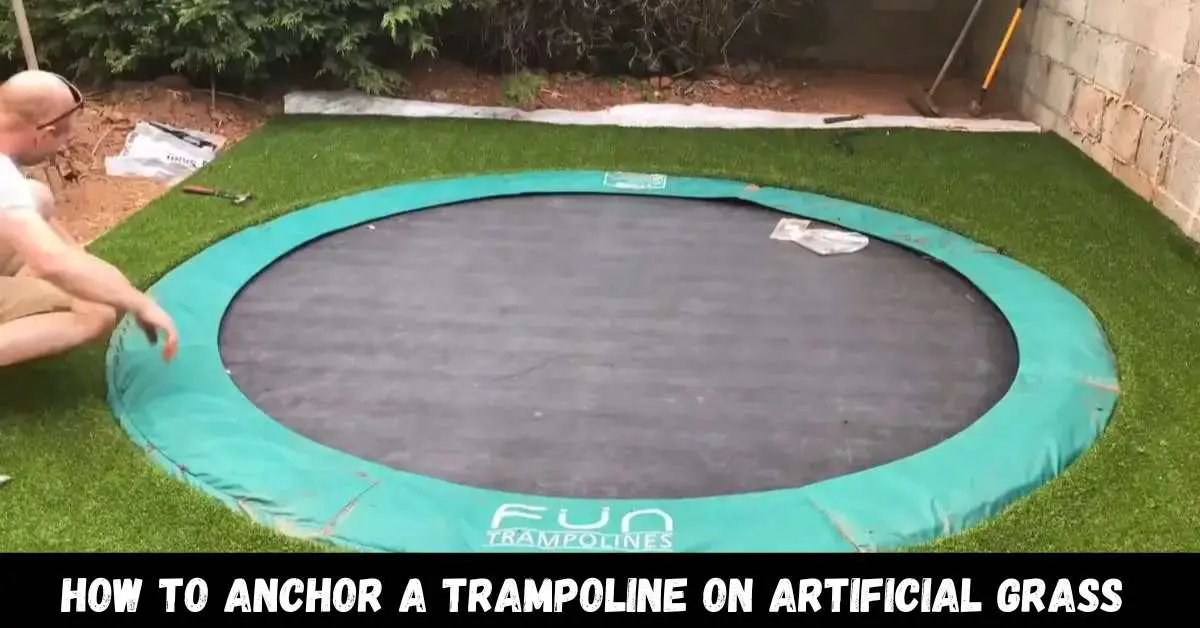I’ve often wondered if it’s possible to place a trampoline on artificial grass. After some research, I’ve found that it is indeed possible! The support bars of a trampoline won’t damage the fake grass, even if they press down on it for years.
However, I did learn that the legs of the trampoline could potentially puncture the grass if not properly addressed. So, when it’s time to move the trampoline off the artificial grass, I’ll make sure to use a stiff brush to carefully brush the grass back up, ensuring it maintains its pristine appearance.
With this information, I’m now confident that I can have the best of both worlds – a trampoline and artificial grass in my backyard!
In this article, we will discuss how to anchor a trampoline on artificial grass.
How to Anchor a Trampoline on Artificial Grass: To anchor a trampoline on artificial grass, use ground anchors or weighted sandbags at each leg’s base to prevent movement and ensure safety during use.
How to Anchor a Trampoline on Artificial Grass?
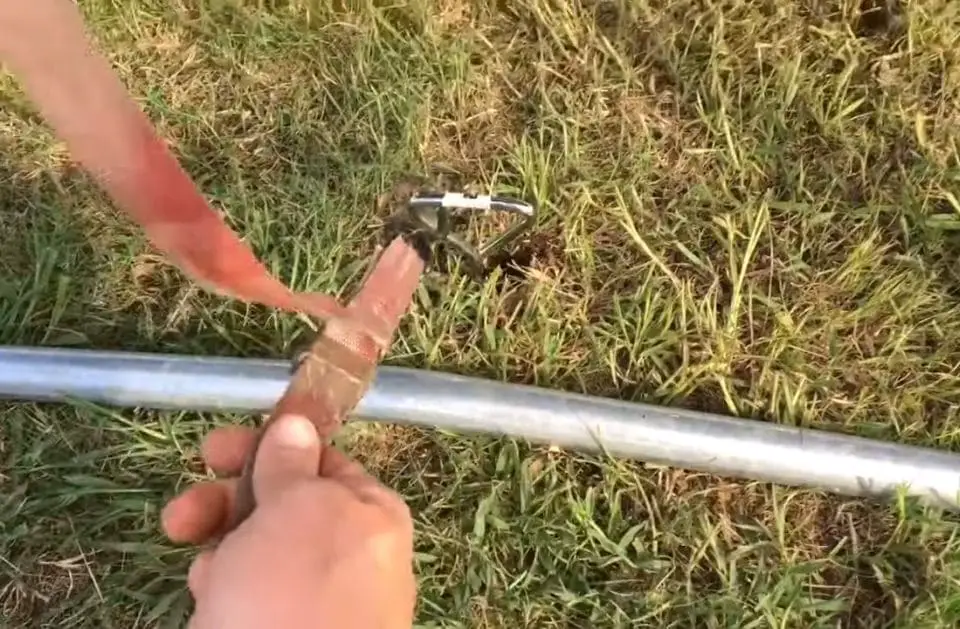
Installing an anchor on artificial grass is quite similar to doing it on real grass, but there are a few extra steps you need to take. It’s not too complicated, and I’ll walk you through the process.
So, let’s get started!
Securing Your Trampoline on Artificial Grass: Step-by-Step Guide
Here are some steps to secure your trampoline on artificial grass:
1. Preparing the Installation Point:
Before cutting into the artificial grass, make sure you’ve carefully chosen the exact spot where you want your trampoline to be, as well as the position of the anchors. Once you’ve decided, gently spread apart the grass fibers and make a small “X” cut to insert your anchor.
2. Choosing the Right Spot:
If you’re using an auger-style anchor, choose a spot between the two legs of the trampoline but slightly inward. However, for U-shaped anchors, select a spot in the middle of each leg of the trampoline.
3. Securing Your Trampoline on Artificial Grass:
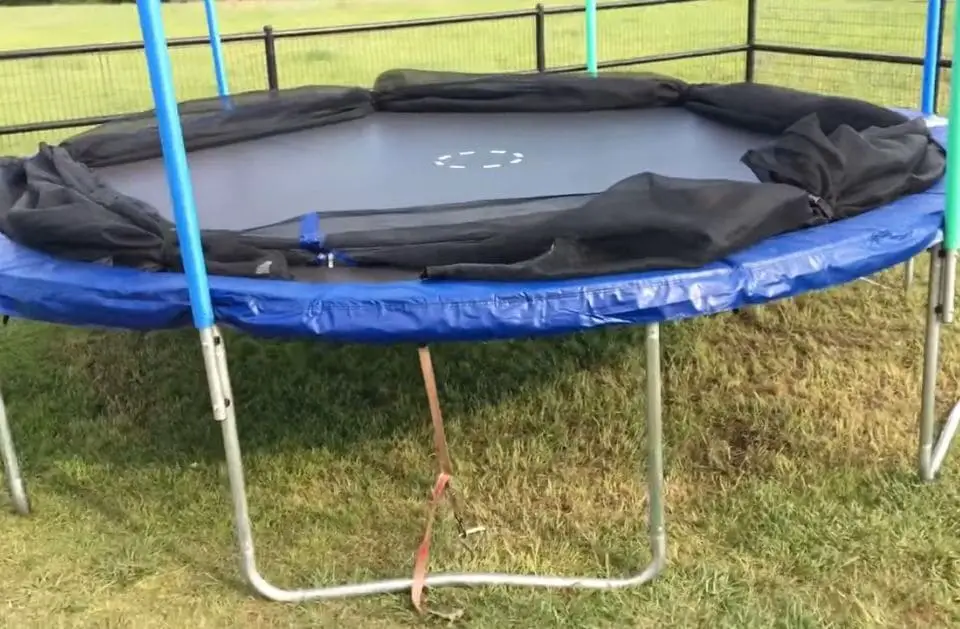
Installing the anchor on artificial grass is a simple process, similar to how it’s done on real grass. To help you better understand, I’ve attached a video for visual guidance.
Required Tools and Materials:
Tools for Anchoring Your Trampoline on Artificial Grass:
- Sharp Cutter
- Screwdriver or Similar Tool
- Trampoline Anchor Kit
- Hammer
Can Trampolines Cause Damage or Burning to Artificial Grass?
In hot climates where temperatures can reach 100-115°F, trampolines can potentially cause damage to artificial grass. The fabric of the trampoline, which is usually black, can absorb heat from the sun and warm up.
If there are reflective objects on the trampoline that reflect light onto the artificial grass, it may cause burning or melting of the grass. To prevent this, it’s recommended to purchase a trampoline cover.
Although it may be inconvenient to take on and off, a trampoline cover can protect your artificial grass from potential damage caused by the heat of the trampoline.
What benefits does placing a trampoline on artificial grass offer?
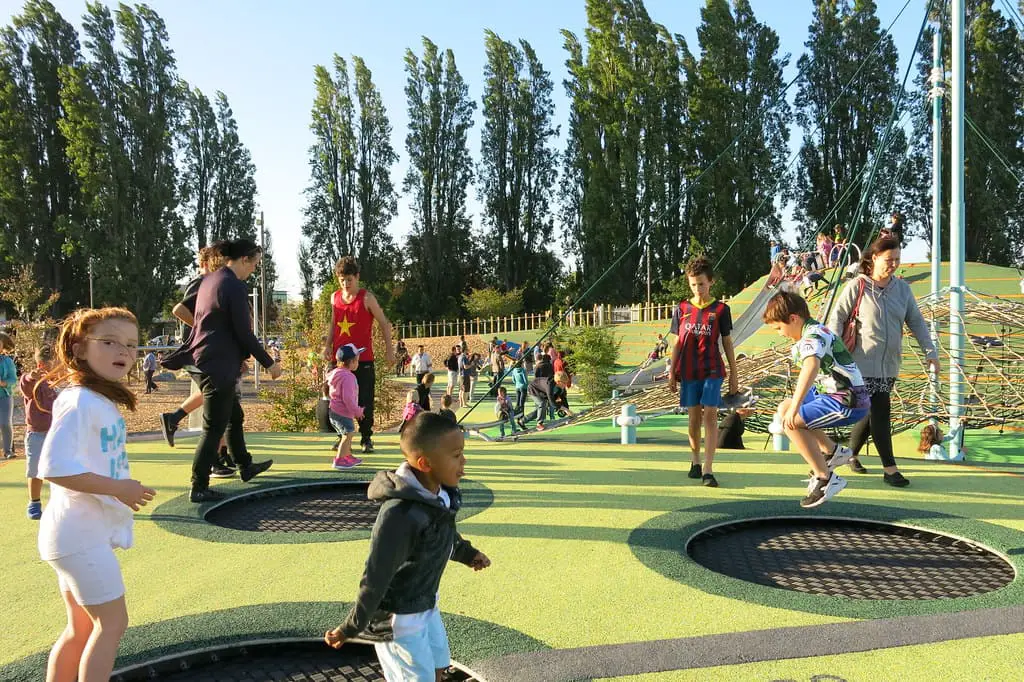
Trampolines are a fun and effective way to exercise, and using them on artificial grass can provide additional benefits. Fake grass is a softer surface compared to concrete, making it more forgiving for jumping and landing.
Trampolines can help improve coordination and balance, and provide a safe environment to practice new tricks and stunts.
Trampolines are a fun and effective way to exercise, suitable for people of all ages and abilities. They provide a low-impact workout and offer an enjoyable way to have fun.
Trampolines can also be used to practice new tricks and stunts, and when used on artificial grass, they provide a softer and more forgiving surface compared to concrete.
Trampolines are a fantastic way to improve coordination, balance, flexibility, and strength. They offer a fun way to get exercise while enjoying the thrill of bouncing.
What is the Weight limit for placing objects on Artificial grass?
Fake grass is not meant to withstand the weight of a trampoline, as it can cause the grass to sink and create an uneven surface. This can be unsafe for both the users of the trampoline and the fake grass. It is not recommended to place a trampoline on fake grass.
However, if you still choose to do so, make sure the fake grass is secured properly and that the trampoline is not too heavy.
What Factors Should You Consider When Selecting a Trampoline for Use on Fake Grass?
When selecting a trampoline for use on fake grass, there are a few factors to consider. Firstly, make sure to choose a trampoline that fits the available space, considering its size and shape.
Additionally, be mindful of the weight limit, as it should be sufficient to support the intended users without risking collapse.
When choosing a trampoline for use on fake grass, remember to also consider the type of springs it has, as this affects how bouncy it is.
Additionally, ensure that the trampoline comes with a safety net to prevent accidents. By keeping these factors in mind, you can find the perfect trampoline for your needs.
Which is better, Artificial grass or Concrete?
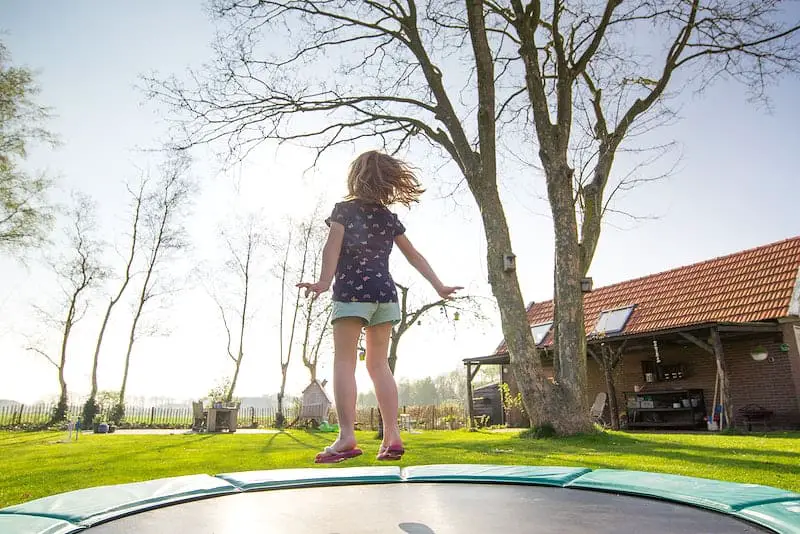
Nowadays, many people are opting for artificial grass instead of real grass or concrete in their backyards for several reasons. Artificial grass requires very low maintenance compared to real grass, making it a more convenient option.
It also offers safety benefits, such as reducing the risk of allergies, pests, and injuries associated with real grass.
Additionally, artificial grass often has an attractive appearance and remains lush and green all year round, regardless of weather conditions, making it a popular choice for many homeowners.
A Safety:
Artificial grass is a safer option compared to real grass or concrete when it comes to placing a trampoline. Concrete surfaces can be hard and pose a risk of accidents, whereas artificial grass acts as a cushion, reducing the chances of injuries from falls.
The Low Maintenance:
Artificial grass requires less maintenance compared to real grass, especially when used under a trampoline. Real grass may not receive sunlight under the trampoline and can require watering, mowing, and pest control.
On the other hand, artificial grass only needs basic maintenance such as regular cleaning to remove dust, dirt, and leaves, making it a low-maintenance option for trampoline areas.
An Appearance:
You may notice less grass growing under the trampoline compared to the surrounding area. This is because the black mat of the trampoline absorbs sunlight, which is needed for grass to grow. This can result in an uneven or patchy appearance.
Using artificial grass under your trampoline can be a better option, as it looks green and uniform, providing a pleasing aesthetic and avoiding the issue of grass growth being affected by the trampoline. It feels good and looks good at the same time.
Troubleshooting and Common Issues
When it comes to using a trampoline on fake grass, there may be some troubleshooting and common issues that you might encounter. Here are some of them:
Troubleshooting common problems with trampoline anchoring on artificial grass:
Here are some things for troubleshooting common problems with trampoline anchoring on artificial grass:
Insufficient Anchoring:
One common issue with trampoline anchoring on artificial grass is insufficient anchoring. If the trampoline is not anchored properly, it may move or shift during use, posing a safety risk.
This can happen when the anchor stakes are not long enough or not inserted deep enough into the ground. To fix this issue, ensure that you use appropriate length anchor stakes and insert them securely into the ground, preferably hitting the solid ground beneath the artificial grass for maximum stability.
Unstable Ground:
Another potential problem with trampoline anchoring on artificial grass is unstable ground. If the ground underneath the artificial grass is not compacted properly or is uneven, it can affect the stability of the trampoline. This can cause the trampoline to wobble or tilt during use.
To resolve this issue, make sure that the ground underneath the artificial grass is properly compacted and leveled before installing the trampoline. You may need to add additional layers of sand or gravel to create a stable base for the trampoline to anchor into.
Solutions and Fixes for Potential Issues:
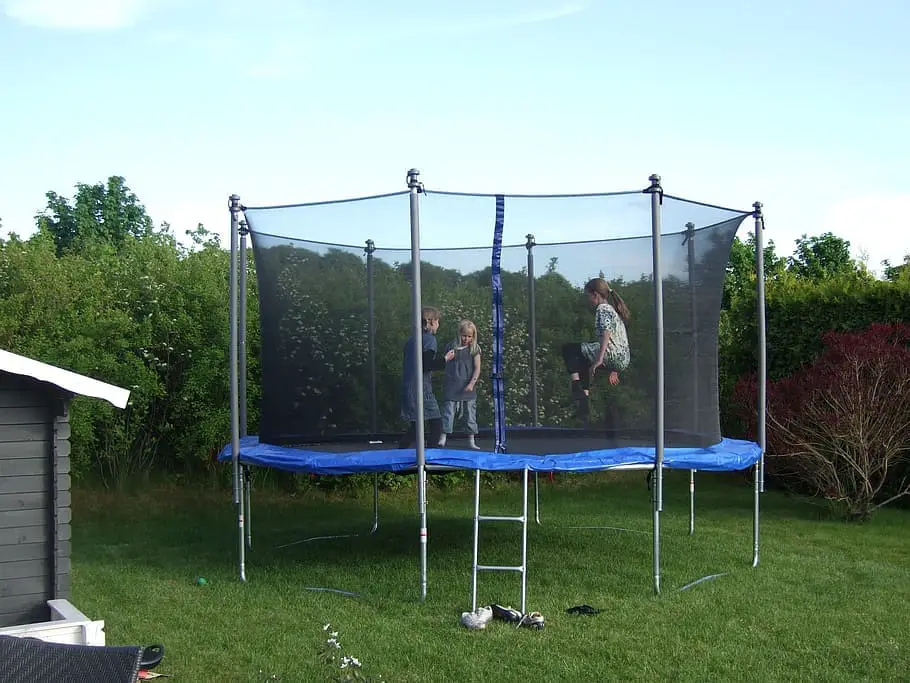
Here are some steps for solutions and fixes for potential issues:
Use Heavy-Duty Anchor Stakes:
When anchoring a trampoline on artificial grass, it’s important to use heavy-duty anchor stakes that are long enough to reach the solid ground beneath the artificial grass.
Avoid using short or flimsy stakes, as they may not provide enough stability. Look for anchor stakes that are made of durable materials such as steel, and have a length of at least 12-14 inches for maximum effectiveness.
Install a Trampoline Anchor Kit:
Many trampoline manufacturers offer anchor kits specifically designed for anchoring trampolines on various surfaces, including artificial grass.
These kits typically include heavy-duty anchor stakes, straps, and other accessories for securing the trampoline to the ground. Follow the manufacturer’s instructions carefully when installing the anchor kit to ensure proper anchoring and stability.
Check the Ground Condition:
Before installing a trampoline on artificial grass, check the condition of the ground beneath the grass. Make sure it is properly compacted and leveled to provide a stable base for the trampoline.
If the ground is soft or uneven, consider adding additional layers of sand or gravel to create a more stable surface.
Regularly Inspect and Re-Tighten Anchors:
Over time, anchor stakes may loosen due to various factors such as weather conditions, ground settling, and trampoline usage. Regularly inspect the anchor stakes and straps to ensure they are tight and secure. If any anchors are loose, re-tighten them immediately to maintain stability.
Consider Using a Trampoline Tie-Down Kit:
In addition to anchor stakes, you may also consider using a trampoline tie-down kit. These kits typically include straps that can be attached to the trampoline frame and anchored to the ground using stakes or weights.
This provides an additional layer of stability and helps prevent the trampoline from shifting or tilting during use.
Remember to always prioritize safety when installing and using a trampoline on artificial grass. If you encounter any issues or are unsure about proper anchoring, consult the manufacturer’s instructions or seek professional assistance to ensure that the trampoline is securely anchored and safe for use.
Maintaining the Anchoring of a Trampoline on Artificial Grass
Maintaining the anchoring of a trampoline on artificial grass is crucial to ensure its stability and prevent any damage to the lawn. Here are some maintenance tips for anchoring a trampoline on artificial grass:
- Regularly Inspect the Anchoring System: Check the U-shaped wind stakes, auger-style anchors, or other anchoring systems used for the trampoline on artificial grass. Ensure they are still firmly in place and have not shifted or loosened over time.
- Add Silica Sand as Needed: If you have used silica sand as an anchoring method, regularly check the sand levels and add more as needed. Silica sand helps to weigh down the artificial grass and keep it securely anchored to the ground.
- Brush the Sand into the Turf: Use a strong-bristled push broom to brush the silica sand into the artificial grass, ensuring it sinks beneath the blades and reaches the backing. This helps to evenly distribute the sand and enhance the anchoring effect.
- Follow the Manufacturer’s Instructions: Always follow the manufacturer’s instructions and guidelines for anchoring a trampoline on artificial grass. Different trampoline models may have specific requirements for anchoring, and following these instructions can help ensure optimal safety and stability.
- Inspect after Severe Weather: After any severe weather events, such as heavy rain or strong winds, inspect the trampoline and its anchoring system to ensure everything is still in place and functioning properly.
- Consider Seasonal Adjustments: Depending on the climate and weather conditions in your area, you may need to make seasonal adjustments to the anchoring system. For example, during winter months with heavy snowfall, you may need to add additional anchoring or remove the trampoline from the artificial grass to prevent damage.
Regular maintenance and inspections are essential to ensure the trampoline remains securely anchored on artificial grass, providing a safe and enjoyable play area for your family.
Following these maintenance tips can help prolong the lifespan of both the trampoline and the artificial grass.
FAQs:
Q:1 Is it possible to place a trampoline on artificial grass?
Many people choose to install artificial grass as a surface for their trampoline because it provides a soft, durable, and natural-looking option that resembles real grass.
Q:2 Can you securely anchor a trampoline into artificial grass?
Yes, you can anchor a swing set to an artificial grass lawn. The process is similar to anchoring it to a natural grass lawn. With proper installation, you can safely anchor a swing set to artificial grass without causing any damage to it.
Q:3 What are the methods to properly secure a trampoline on grass?
To secure your trampoline on artificial grass, you can use U-shaped wind stakes that go over the legs of the trampoline or auger-style anchors that go into the ground beneath the trampoline frame.
Use the included straps to hook them to the augers and tighten them on each side to keep your trampoline in place, even during harsh weather conditions. It’s a quick and effective way to anchor your trampoline on artificial grass.
Q:4 How can I prevent my trampoline from damaging my artificial grass?
The best solution to prevent your trampoline from damaging the grass is to place it on a patch of artificial turf. Although this may require purchasing additional artificial grass specifically for the trampoline, it is a worthwhile investment in the long term to protect your lawn from damage caused by the trampoline.
Q:5 What is the recommended way to anchor artificial grass for a trampoline?
To properly anchor artificial grass, you can spread a thin layer of silica sand over the lawn. Use a shovel to evenly distribute the sand, and then use a sturdy push broom with strong bristles to brush the sand into the lawn.
The sand will sink beneath the blades and anchor the turf to its backing. It’s recommended to add more sand at least once a year to ensure the artificial grass remains securely anchored and evenly distributed.
Conclusion:
In conclusion, anchoring a trampoline on artificial grass is essential to ensure its stability and prevent any damage to the lawn. There are several methods to securely anchor a trampoline on artificial grass, including using U-shaped wind stakes, auger-style anchors, or placing the trampoline on a patch of artificial turf.
Proper installation and regular maintenance, such as adding silica sand to keep the turf evenly anchored, can help ensure the trampoline remains safely in place, even during harsh weather conditions.
It’s important to follow the manufacturer’s instructions and guidelines when anchoring a trampoline on artificial grass, as improper installation can result in safety hazards and potential damage to both the trampoline and the lawn.
Investing in additional artificial grass specifically for the trampoline or using anchor systems designed for artificial grass can provide long-term protection for your lawn and trampoline.
By taking the necessary steps to anchor a trampoline on artificial grass, you can enjoy the benefits of a safe and secure play area for your family without causing any harm to your lawn.
Regular maintenance and inspections can help ensure the trampoline remains properly anchored and provides a safe and enjoyable experience for everyone.
We hope you will be well aware of how to anchor a trampoline on artificial grass, after reading this comprehensive guide. If you have any questions, feel free to comment below!

